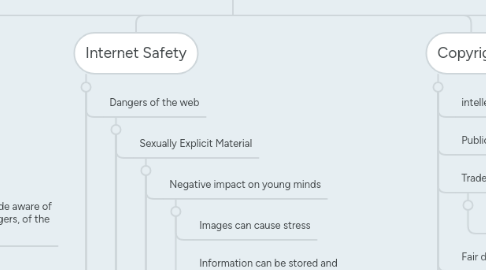
1. Marketing
1.1. Easily reaches youth online
1.1.1. Games
1.1.2. Sidebar ads
1.1.3. immersive
1.1.4. interactive
1.2. Youth are aware that they are being targeted
2. Authenticity of Web Resources
2.1. Internet content must be critically assessed to determine if it is authentic and reliable
2.1.1. Authority
2.1.2. Coverage
2.1.3. Objectivity
2.1.4. Accuracy
2.1.5. Currency
3. Privacy
3.1. Social networks ask for large amounts of personal information to be shared
3.2. Geotagging
3.2.1. Parents and students need to be made aware of the specific functions, and their dangers, of the online resources that they use
3.3. Self Publishing
3.3.1. Audience
3.3.2. Anonymity
3.3.3. Permanence
3.3.4. Copy right
3.3.5. Free Speech
4. Internet Safety
4.1. Dangers of the web
4.1.1. Sexually Explicit Material
4.1.1.1. Negative impact on young minds
4.1.1.1.1. Images can cause stress
4.1.1.1.2. Information can be stored and reconsidered as the child grows older
4.1.1.2. Without proper guidance, youth may create an inaccurate view on sex, sexuality, and sexual relationships
4.1.1.3. Parents can manage what is being viewed through monitoring TV shows, and putting filters on internet search engines
4.1.1.4. Sexting
4.1.1.4.1. Minors can be charged with the creation and distribution of child pornography if they take sexually explicit pictures and share them, of themselves
4.1.2. Cyberbullying
4.1.2.1. Bullying prevention site: http://www.prevnet.ca/
4.1.3. Too much personal information available to the public
4.1.3.1. Doxxing
4.1.3.1.1. The release of personal information onto public domain without permission
4.1.4. False information not filtered out or identitifed
4.1.4.1. students exposed or influenced by misinformation
4.1.5. The ease of plagiarism
4.2. Freedom of Speech
4.2.1. Threats
4.3. Teachers
4.3.1. In Loco Parentis
4.3.1.1. A teacher's responsibility to watch over their students
4.3.2. Ensuring safe and appropriate use of the internet
4.3.2.1. Teaching and demonstrating professionalism
4.4. Snapchat
4.4.1. How are students using it?
4.4.1.1. Communication?
4.4.1.2. Exploitation?
4.4.1.3. How does the format affect students and the information they view/share?
5. Copyright
5.1. intellectual property
5.2. Public domain
5.3. Trademark
5.3.1. Genericized trademark
5.4. Fair dealing
5.5. Fair use
5.6. Technological protection measures
5.6.1. Digital locks
5.7. Copyright
5.7.1. Copying and pasting from the internet
5.7.1.1. May infringe copyright laws
6. Digital Citizenship
6.1. Prepares online literacy
6.1.1. Students
6.1.2. Parents
6.2. Rules
6.2.1. Respect
6.2.1.1. Respect yourself
6.2.1.2. Respect others
6.2.1.3. Respect intellectual property
6.2.2. Appropriate behavior
6.2.2.1. Digital Access
6.2.2.2. Digital Commerce
6.2.2.3. Digital Communication
6.2.2.4. Digital Literacy
6.2.2.5. Digital Etiquette
6.2.2.6. Digital Law
6.2.2.7. Digital Rights and Responsibilites
6.2.2.8. Digital Health and Wellness
6.2.2.9. Digital Security
6.2.3. Netiquette
6.2.3.1. How we behave and interact online
6.2.3.2. Flaming: provoking arguments
6.2.3.2.1. Trolls
6.2.3.3. Ability to be anonymous makes people brave
6.2.3.4. Treat others the way you want to be treated
6.2.3.5. Clarity
6.2.3.5.1. appropriate use of language depending on audience
6.2.3.5.2. humor and sarcasm are difficult to portray through writing
6.2.3.5.3. proofread
6.2.3.6. Permission from others before posting content including them
6.3. Ethics
6.3.1. Identity
6.3.2. Privacy
6.3.3. Ownership
6.3.4. Trustworthiness
6.3.5. Participation
6.4. Digital Presence Link
6.4.1. Search Myself
6.4.1.1. Google Search
6.4.1.1.1. No sign of me on the first three pages.
6.4.1.1.2. Included middle name, still no sign on first three pages
6.4.1.2. Pipl.com
6.4.1.2.1. No sign of me here
7. Online Learning
7.1. Greater access to courses
7.1.1. benefit for small and rural schools
7.2. 24/7 access
7.2.1. Work at your own pace
